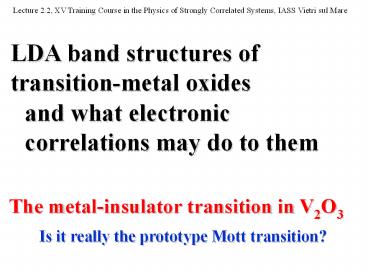LDA band structures of transition-metal oxides - PowerPoint PPT Presentation
Title:
LDA band structures of transition-metal oxides
Description:
Lecture 2.2, XV Training Course in the Physics of Strongly Correlated Systems, IASS Vietri sul Mare LDA band structures of transition-metal oxides – PowerPoint PPT presentation
Number of Views:127
Avg rating:3.0/5.0
Title: LDA band structures of transition-metal oxides
1
Lecture 2.2, XV Training Course in the Physics of
Strongly Correlated Systems, IASS Vietri sul Mare
LDA band structures of transition-metal oxides
and what electronic correlations may do to them
The metal-insulator transition in V2O3
Is it really the prototype Mott transition?
2
1 T. Saha-Dasgupta, O.K. Andersen, J. Nuss,
A.I. Poteryaev, A. Georges, A.I. Lichtenstein
arXiv 0907.2841. 2 A.I. Poteryaev, J.M.
Tomczak, S. Biermann, A. Georges, A.I.
Lichtenstein, A.N. Rubtsov, T. Saha-Dasgupta,
O.K. Andersen Phys. Rev. B 76, 085127 (2007)
3 F. Rodolakis, P. Hansmann, J.-P. Rueff, A.
Toschi, M.W. Haverkort, G. Sangiovanni, A.
Tanaka, T. Saha-Dasgupta, O.K. Andersen, K. Held,
M. Sikora, I. Alliot, J.-P. Itié, F. Baudelet,
P.Wzietek, P. Metcalf, M. Marsi Phys. Rev. Lett.
104, 047401 (2010). 4 S. Lupi, L. Baldassarre,
B. Mansart, A. Perucchi, A. Barinov, P. Dudin, E.
Papalazarou, F. Rodolakis, J.-P. Rueff, J.-P.
Itié, S. Ravy, D. Nicoletti, P. Postorino, G.
Sangiovanni, A. Toschi, P. Hansmann, N.
Parragh, T. Saha-Dasgupta, O.K. Andersen, K.
Held, M. Marsi (accepted)
3
Doped Mott Insulators have rich physical
properties and controlling them is one of the
major challenges for developing Advanced Materials
High-Temperature Superconductors Colossal
Magneto-Resistance Materials Intelligent Windows,
Field-effect Transistors
4
Mott transition in cuprate HTSCs
Wannier orbital Conduction band (LDA)
T. Saha-Dasgupta and OKA 2002
5
(No Transcript)
6
- Electronic-structure calculations for
materials with strong correlations - Current approximations to ab inito
Density-Functional Theory (LDA) are insufficient
for conduction bands with strong electronic
correlations, e.g. they do not account for the
Mott metal-insulator transition. - On the other hand, LDA Fermi surfaces are
accurate for most metals, including overdoped
high-temperature superconductors. - Presently, we therefore start with the LDA.
For the few correlated bands, we then construct
localized Wannier orbitals (NMTOs) and a
corresponding low-energy Hubbard Hamiltonian
HLDA Uon-site. This is solved in the dynamical
mean-field approximation (DMFT).
7
(No Transcript)
8
V 3d2
9
LDA band structure of V2O3 projected onto various
orbital characters
EF
EF
Blow up the energy scale and split the panels
Pick various sub-bands by generating the
corresponding minimal NMTO basis set
EF
For the low-energy Hamiltonian we just need the
t2g set
EF
N2
N2
N2
N1
10
V2O3 3d (t2g)2
a1g-egp crystal-field splitting 0.3 eV
Hund's-rule coupling J0.7 eV
11
LDA t2g NMTO Wannier Hamiltonian
LDADMFT
12
(No Transcript)
13
More important for the temperature dependence of
the conductivity is, however, that internal
structural parameters of V2O3 change with
temperature, as we shall see later.
14
LDA t2g NMTO Wannier Hamiltonian
LDADMFT
15
(No Transcript)
16
t -0.72 eV
17
t -0.49 eV
18
t -0.72 eV
t -0.49 eV
19
(No Transcript)
20
T300K
V2O3
(V0.96Cr0.04)2 O3
undo a1g-egp
undo a1g-egp
LDA
LDA
1.7
2.0 eV
Robinson, Acta Cryst. 1975 (V0.99Cr0.01)2
O3
V2O3 at 900K
V2O3 at 300K
undo a1g-egp
undo a1g-egp
LDA
LDA
1.9
1.6
21
(No Transcript)
22
(No Transcript)
23
Conclusion In the (t2g)2 system V2O3, described
by an LDA t2g Hubbard model, the metal-insulator
transition calculated in the DMFT is caused by
quasi-particle bands being separated by
correlation-enhanced a1g-egp crystal-field
splitting and lattice distortion. The driving
mechanism is multiplet splitting (nJ) rather than
direct Coulomb repulsion (U). The a1g electrons
stay coherent to higher temperatures (450K)
than the egp electrons (250K).

